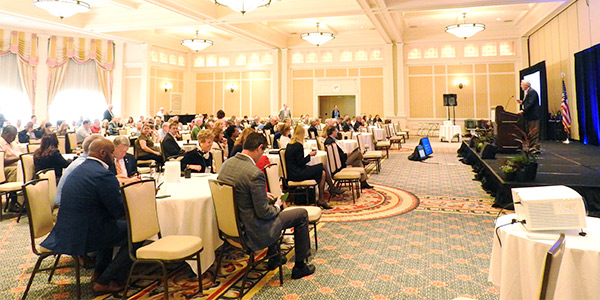By Christen Smith
HOT SPRINGS, Va. — Regulators from NYISO and PJM descended upon the historic Omni Homestead Resort last week for the 24th annual Mid-Atlantic Conference of Regulatory Utilities Commissioners (MACRUC) Education Conference to discuss how states and industry can work together to usher in new resource technologies and grid innovations.
“We must embrace the future,” Dallas Winslow, chairman of the Delaware Public Service Commission and outgoing MACRUC president, said during his opening remarks. “By being prepared and embracing the future, we will succeed in meeting the challenges of a changing utility landscape.”
Green transformation in the utility sector dominated conversation — from how to align clean energy with customer demand, to ensuring equal access to electricity, to defining which generators belong in a net-zero-carbon grid. Most presenters agreed there’s no reason to wait on the transportation or agriculture industries to reduce emissions and reverse climate change — the utility sector must forge ahead.
“These efforts will have a cost,” Bruce Burcat, executive director of the Mid-Atlantic Renewable Energy Coalition, said while moderating a breakout panel about the Green New Deal. “But the possibility of not doing enough about climate change will have a higher cost.”
The Green New Deal, a Democrat-backed proposal to address both income inequality and climate change, sets broad targets for clean energy investment, weatherization projects and infrastructure upgrades. But MACRUC panelists said its lofty ambitions don’t translate into any sort of attainable plan.
“I think we have to act quickly,” Burcat said. “I do think the problem is clear. We need to come up with a plan that really deals with this. We are facing a really serious problem in 20 years from now when climate gets really out of control. To sit on our hands and wait is really not a good solution.”
Burcat argued renewables hold the key to decarbonizing the electricity sector but admitted the “aggressive” goals of the Green New Deal seem “unrealistic, cost-prohibitive and unachievable.” Instead, he called or a “rational” cost for carbon reduction.
“What is the goal? Is it to reduce carbon? Renewables is one way, but it’s not the only way,” said Marji Philips, director of RTO and federal services for Direct Energy. “We need to find a lot of ways to do it.”
She said tax credits, cap-and-trade programs and carbon pricing appear to be the most efficient ways to encourage decarbonization, but she argued the influx of subsidies, limitations of storage technology and existing PJM market construct issues — such as the cost of interconnecting renewables and unreliable pricing models — will prove challenging.
“The reality of decarbonization is its expensive,” she said. “It’s achievable, but it depends on how flexible you want to make your system.”
Philips said injecting more money into the market — instead of subsidies for struggling nuclear reactors, for example — would allow cleaner, more efficient resources to come in while still preserving profitable nuclear units.
“The markets have been really great at incenting entry and pretty lousy at exiting, and that’s partly the regulators fault,” she said.
Dana Horton, director of RTO regulatory affairs for American Electric Power, and Brooks McCabe, chairman of the West Virginia Public Service Commission and incoming MACRUC president, said states flush with fossil fuels in the western half of PJM don’t see a way to protect their ratepayers from the effects of a carbon tax — despite optimism from stakeholders in the east who think avenues exist to prevent emissions and economic leakage.
“Without a regional or national adder approach, it’s just not feasible,” Horton said during a panel about PJM’s new effort to explore carbon pricing mechanisms in the RTO. “The more adders you put into the equation, the more complicated it is [and] the more potential for unintended consequence. Forcing a solution before we are ready is a mistake.” (See “PJM Offers Peek at Carbon Pricing Study,” PJM MIC Briefs: May 15, 2019.)
“Maryland and West Virginia have very different views of the world,” McCabe said. “When you put a piece of the equation on the side and try to make a decision based on that isolated aspect, that’s getting into dangerous territory.”
Chatterjee ‘Bullish’
FERC Chairman Neil Chatterjee sounded far more optimistic about the proliferation of natural gas across the world and the rise of renewable resources.
“I’m very, very bullish about the future of renewables,” he said. “There is a very strong business case to be made for renewables. … If you have a source that has no fuel cost, that source is going to prevail over time.”
Chatterjee was criticized in June for tweeting the hashtag “freedom gas” after Energy Secretary Rick Perry coined the term to describe U.S. LNG displacing Russian gas in Europe. Some said his comment broke FERC’s fuel-neutral policy.
The chairman was unfazed.
“You can’t ignore the geopolitical impacts of the U.S. being a net exporter in this industry,” he said. “That’s a very, very exciting thing.”
He also described Order 841-A, which denied rehearing of FERC’s 2018 order removing barriers to energy storage, as one of the commission’s most important rulings. the commission issued this year. “I think we may look back a decade from now and say that Order 841 was one of the most significant federal actions we took to reduce carbon emissions,” he said. (See FERC Upholds Electric Storage Order.)
FERC Commissioner Bernard McNamee told attendees he doesn’t know what the future holds, but he assured regulators the commission is trying its best to translate federal policy into actionable regulations.
“When policy comes out from Congress, it’s a broad statement,” he said. “Very often we have to translate it to something very specific. You’re [state regulators] the ones that have to make it work.
“We are trying to give orders that make a little bit more sense in your states,” he continued. “Doesn’t mean that it’s perfect, but we try very hard to make the orders that come out FERC useful to you all.”








